How do I clean my tongue?
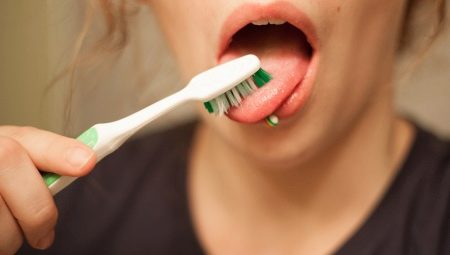
In the modern world, all people know how important it is to maintain oral hygiene - to brush your teeth with toothpaste, use a floss and rinse. But not everyone knows that the tongue also needs to be cleaned of contamination, because its heterogeneous surface without proper care can easily become a breeding ground for harmful microorganisms. In addition, plaque on the mucous membrane can be accompanied by an unpleasant odor or dental diseases. To help you avoid many unpleasant consequences, we have prepared an article on the specifics of tongue hygiene.
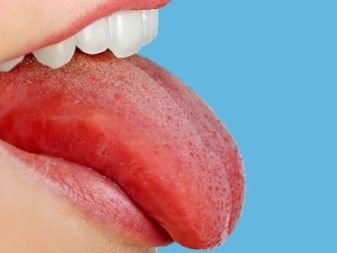

The benefits and harms of cleaning
The human digestive system is very complex - it consists of many organs that perform important functions. The tongue is the initial stage of the whole process, it helps to chew food, envelops it with saliva and participates in swallowing. The back of this organ is completely covered with multiple outgrowths, papillae, thanks to which a person feels taste and feels pain from stimuli. But because of this structure, food remains are deposited in the grooves of the muscle - this leads to the appearance of plaque and bad breath.
It is necessary to clean the tongue regularly, because this not only avoids problems with the oral cavity, but also improves the overall functioning of the digestive system.
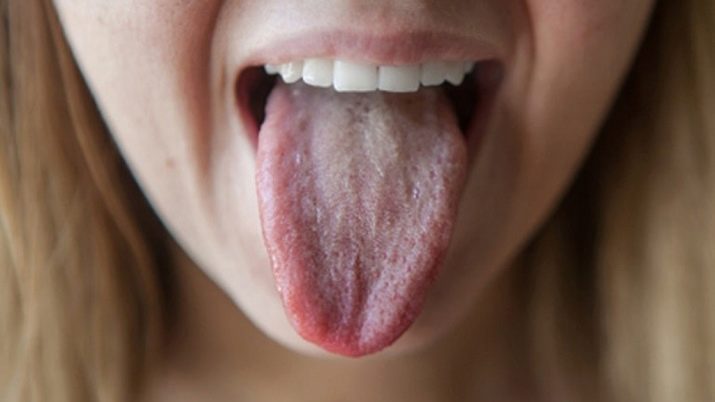
There are quite a few advantages in oral hygiene, but in everything you need to know when to stop, otherwise the procedure can become harmful to human health.... Before starting to remove dirt from the surface of the taste organ at home, you must carefully read the instructions and read the warnings. Let's take a look at the benefits of tongue cleaning first.
- The process of food digestion is improved. The muscle covered with taste buds is the first to come into contact with food, so it is a very important part of the digestion process. When a lot of plaque accumulates on the back of an organ, it will not be able to accurately recognize the type of food coming in, therefore, it will not give a signal for the production of necessary digestive enzymes. By cleansing your tongue, you keep your body healthy and the digestive system efficient.
- Eliminates bad breath... Each person strives to achieve fresh breath, because the comfort of communication with relatives, friends and colleagues depends on this. But brushing your teeth thoroughly is not always enough to achieve the goal - the root of the tongue contaminated with bacteria often becomes the source of the unpleasant odor. In the root zone of the taste organ, food debris, mucus from the nasopharynx, including after colds, as well as harmful microorganisms are collected. Such a bouquet of impurities causes diseases of the oral cavity such as tooth decay or stomatitis. Do not forget that there are beneficial bacteria in the oral mucosa that protect against problems, but they are effective only if the microflora is balanced.
- The taste buds become more sensitive. You can make your life brighter and better by removing plaque from the back of the taste bud. Eating food is one way to get pleasure, and if you keep the receptors clean, the taste will be brighter.


Now let's look at the harm from improper cleaning of the oral cavity.
- Injury from careless cleaning. The human tongue is a very sensitive organ, it consists of 17 strong muscles that cover multiple outgrowths-papillae. Such a coating is very delicate, so you cannot use brushes and spoons too often to clean the body of the gustatory organ, in addition, it is forbidden to press the instruments strongly against the surface - this can disturb the perception of taste. Receptors will restore their work over time, as, for example, after a burn, but cleaning should not be overused.
- Destruction of beneficial microorganisms. On the mucous surface of the oral cavity there are more than 700 different types of beneficial bacteria that are involved in processing food and protecting the body from disease. Frequent cleaning is harmful to the natural microflora - a person's immunity and digestion can be impaired.
- Commercial benefit... Many companies seek to make money from the production of oral hygiene products - professional advertising convinces people that cleaning the tongue should be done in the morning and every day. But this approach can be harmful to health, because often scraping off white plaque, you destroy beneficial bacteria.
From the above, we can conclude that cleaning the tongue is a very useful and effective procedure, but you need to know when to stop. In addition, plaque on the taste organ can have a different nature of origin - most often it is within the normal range, but there are times when the color and texture of the receptors indicate some kind of serious illness.

If you have not eaten food with dyes, and the surface of the tongue has a greenish, brown or black tint, do not try to remove the dirt yourself, it is better to consult a doctor for advice.
How can plaque be cleansed?
There are quite a few devices and tools designed to remove dirt from the surface of the tongue. Some cleaning methods are advised by professional dentists, while others have been passed on by parents to children for a long time. Within reasonable limits, each cleaning method is quite effective, so anyone can choose the most comfortable option for themselves.

Let us consider in more detail the tools and methods of traditional medicine for oral hygiene.
Gadgets
The surface with receptors is cleaned with simple devices using mechanical movements.The stain remover can be purchased at the pharmacy as well as at your regular supermarket. We present you with a list of devices suitable for cleansing the mucous surface.
-
Toothbrush. On many brushes of the middle and high price segments, there is a special insert on the back of the head - a rough silicone surface designed to remove dirt from the tongue and the inner side of the cheeks. And also for a hygienic procedure, you can use a toothbrush without an additional pad - using its usual bristles, but before the process, you must thoroughly rinse the villi under running water.
In order to cleanse the receptors from harmful microorganisms, a small amount of toothpaste is added to the brush.
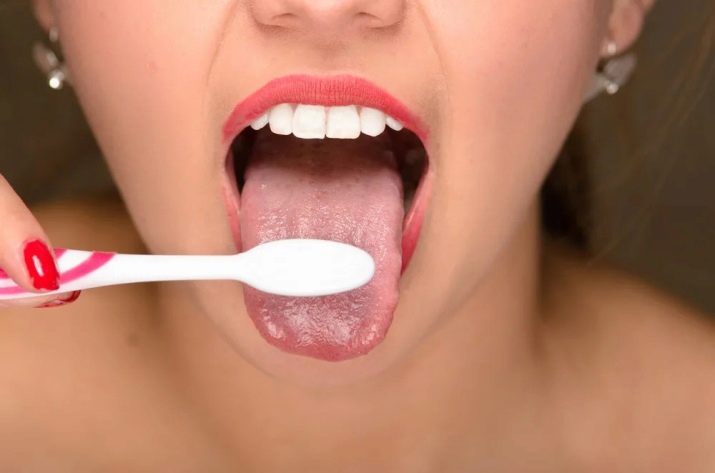
- Scraper... A tool designed specifically to remove plaque from the surface of the gustatory muscle. The structure consists of a handle-holder and an elongated loop at the end, the item is made of safe plastic.
The scraper effectively and accurately cleans the surface of various contaminants - for this you just need to draw a loop from the root of the tongue to the tip.
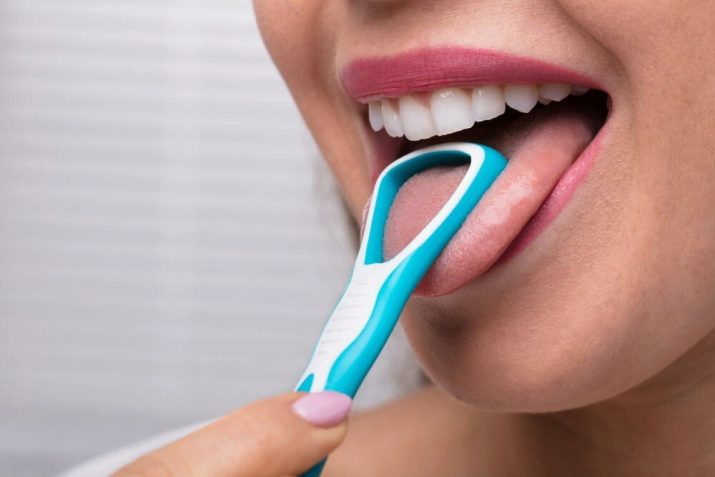
- Gauze or bandage. A very simple but effective tool. For a hygienic procedure, wrap cheesecloth around your finger, moisten it with water and add some toothpaste on top. After that, make mechanical movements with the device starting from the base of the tongue.
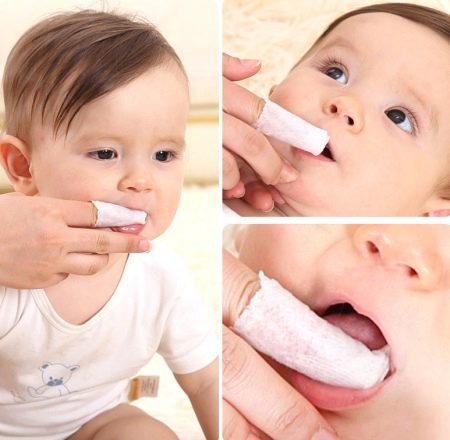
- Spoon... Such a device can be found in a pharmacy - outwardly it resembles a small fan with a long handle. The angles on the scapula are smoothed to eliminate the possibility of oral injuries. The hygienic tool is made of plastic, safe for allergy sufferers. To clean the tongue, you must first thoroughly wash the instrument under running water and, if possible, treat it with an antiseptic. Then you need to make light movements with the spoon along the coating of the organ of taste - repeat the movement until you have cleared all the impurities.
Instead of a special device, you can use an ordinary teaspoon, but it is better to choose a silver one - it copes more effectively with pathogenic microflora.

Funds
Specialty cleaning products can be both industrial and homemade. We will describe several agents that effectively remove plaque from receptors.
- Gel... The gel cleansing procedure is suitable when the oral cavity is very sensitive to mechanical stress. In addition, the agent has a wound-healing effect, and also effectively removes harmful microorganisms, while not harming the human body.
- Toothpaste... With the help of this tool, you can qualitatively clean the surface of the taste organ from white plaque. Toothpaste is used in different ways - applied to the tongue with a brush, scraper or gauze. In addition, sometimes people create a solution from water and a paste - they get a home-made rinse aid.
- Herbal decoction. A remedy from traditional medicine can be represented by a decoction of various medicinal herbs such as mint, calendula, chamomile and St. John's wort. This tincture thoroughly rinses the oral cavity - this removes white plaque, removes pathogenic microorganisms and nourishes the gums with useful substances.
- Pieces or propolis solution... This method will save you when there are no other means for cleaning the oral cavity - propolis has antibacterial properties.
- Fruits... Finish your meal with a variety of fruits, because the substances they contain clean the oral cavity no worse than special devices.

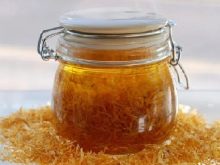
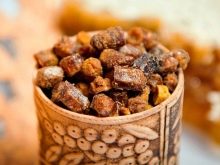
Instructions
Before starting to remove plaque from the tongue, you must first whiten your teeth. The procedure for cleaning the organ of taste is not done too often, but the hygiene of the incisors, canines and molars must be observed 2 times a day. Brushing your teeth removes most of the plaque and harmful bacteria, making your tongue much less dirty.
There are many tools and methods to remove contamination from the uneven surface of the taste organ. Unless you have any specific advice from your dentist or gastrointestinal ailments, a hygienic tongue cleaning procedure is just a small addition to brushing your teeth. Let us consider in more detail the sequence of actions in the process of removing contaminants.
- Start the procedure only after finished brushing your teeth and rinsing the mouth.
- Open your mouth and stick out your tongue so that it is easy to clean.
- With the help of special devices or tools cleanse the tongue... Mechanical manipulations must begin where the root of the tongue is located, and continue the sweeping movement to the very tip.
- After each carrying out it is necessary rinse the instrument under water, to prevent the removed plaque from falling back on the taste buds.
- The procedure is not very pleasant - if you try to reach the very base of the tongue the first time, it can cause a gag reflex. Therefore, you should not be zealous, it is better to start cleaning the body of the tongue, gradually getting used to the procedure.
- After brushing from root to edge, use a regular toothbrush - Run the bristle across your tongue 5-6 times. Then repeat the procedure in the opposite direction - from the tip of the organ of taste to the base.
- After performing all the manipulations, carefully rinse mouth with water at room temperature or a special decoction.

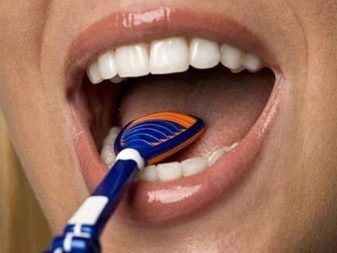
Young parents are often interested in how to maintain oral hygiene for newborn children, because they are at a high risk of infectious diseases - young immunity is not yet strong enough to resist most pathogenic bacteria. Therefore, there is a way to clean the cheeks, gums and tongue from a very young age - until milk teeth appear. For the procedure, special silicone fingertips with soft bristles are produced, which are safe for the baby's delicate mucosa.
To clean the child's oral cavity, it is necessary to put the device on the finger and with careful movements in one direction "sweep" the dirt. After manipulating the back of the tongue, you can walk the fingertip along the lateral parts of the tongue, the inner side of the cheeks and the surface of the gums.
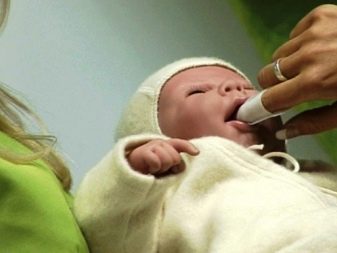

When you are done, be sure to give your baby some water so that he can rinse out the mouth. Since newborns do not know how to rinse and spit out water, gel and toothpaste cannot be used for cleaning.
Simple oral hygiene prevention will save children and adults from the extra costs of treating tooth decay, stomatitis or other diseases. Therefore, it is necessary to teach a child to clean the oral cavity from a very young age - the sooner you start, the longer you won't need dentist services.









